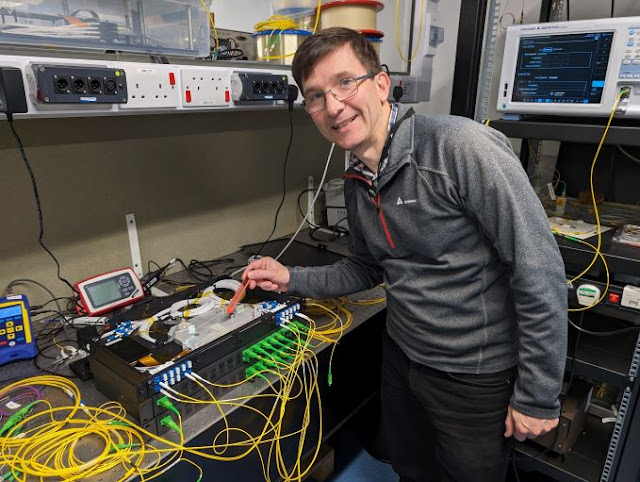Data transfer speeds 4.5 million times faster than broadband? Aston University researchers make it a reality! Their discovery unlocks new possibilities within fiber optic technology, boosting future internet capabilities.
UK:
Researchers at Aston University have made a significant breakthrough in data transmission, achieving speeds 4.5 million times faster than the average broadband rate. This feat, accomplished using existing fiber optic cables, paves the way for a future with vastly improved internet connectivity.
Aston University revealed this information on Tuesday, March 26, 2024.
The international team, comprising researchers from Aston University, National Institute of Information and Communications Technology (NICT) in Japan, and Nokia Bell Labs in the USA, successfully transmitted data at a staggering 301 terabits per second (Tb/s) – the equivalent of 301,000,000 megabits per second.
This stands in stark contrast to the average UK broadband speed of just 69.4 megabits per second, as reported by Ofcom in September 2023.
Professor Wladek Forysiak from Aston Institute of Photonic Technologies and Dr Ian Phillips played key roles in this accomplishment. Their technique utilizes unused wavelength bands within standard fiber optic cables, significantly increasing data capacity without the need for new infrastructure.
"By increasing transmission capacity in the backbone network, our experiment could lead to vastly improved connections for end users," said Professor Forysiak. "This groundbreaking accomplishment highlights the crucial role of advancing optical fiber technology in revolutionizing communication networks for faster and more reliable data transmission."
The research team achieved this breakthrough by unlocking new possibilities within the fiber optic spectrum. Traditionally, data transmission has relied on the C and L-bands.
However, researchers leveraged the E-band, which is adjacent to the C-band and boasts a three times wider capacity. Dr. Phillips led the development of a crucial component – an optical processor – that enabled them to effectively utilize the E-band.
"Over the last few years, Aston University has been developing optical amplifiers that operate in the E-band," explained Dr. Phillips. "Before the development of our device, no one had been able to properly emulate the E-band channels in a controlled way."
This innovation promises not only increased data speeds but also a more sustainable solution. "Growing system capacity by using more of the available spectrum...can help to keep the cost of providing this bandwidth down," said Professor Forysiak. "It is also a ‘greener solution’ than deploying more, newer fibres and cables since it makes greater use of the existing deployed fibre network."
The findings from this groundbreaking experiment were published by the Institute of Engineering and Technology (IET) and presented at the European Conference on Optical Communication (ECOC) held in Glasgow, October 2023.
